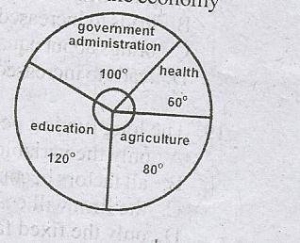Year :
2016
Title :
Economics
Exam :
WASSCE/WAEC MAY/JUNE
Paper 1 | Objectives
1 - 10 of 50 Questions
| # | Question | Ans |
|---|---|---|
| 1. |
Human wants are insatiable because wants are A. limited while means are scarce B. unlimited and means are also unlimited C. limited and means are also limited D. unlimited while means are scarce |
D |
| 2. |
Scale of preference is important for the following reasons except in A. satisfying wants B. making rational C. making optinum allocation of resources D. using scarce resources efficiently |
A |
| 3. |
In a socialist economy, prices of commodities are determined by A. forces of demand and supply B. producers of the commodities C. the central planning authority D. consumers who are sovereign |
C |
| 4. |
Which of the following cannot be classified as land in economics A. Bauxite deposit in the ground B. A lake used for irrigation C. A bulldozer for clearing farm land D. Grazing field for cattle |
C |
|
A country allocation to various sectors of the economy is shown in the pie chat below, use it to answer question 5 and 6. |
||
| 5. |
If the budget of the country was $7,200, how much is allocated to Education? A. $2,400.00 B. $2,000.00 C. $1,200.00 D. $1,000.00 |
A |
| 6. |
What is the ratio of expenditure on health to agriculture? A. 2.3 B. 3.4 C. 4.3 D. 5.4 |
B |
| 7. |
The demand curve for neccessity is usually A. vertical B. backward bending C. horizontal D. negatively sloped Detailed SolutionNecessity goods are products and services that consumers will buy regardless of the changes in their income levels, therefore making these products less sensitive to income change. |
|
| 8. |
What effect will an increase in price have on the total revenue of a firm whose product has inelastic demand? total revenue will A. increase B. fall C. fluctuate D. remain unchanged Detailed Solutionif prices for inelastic goods are increased, the total revenue increases, but it would lead to a small decrease in quantity demanded. This means that firms that deal in inelastic goods or services can increase prices, selling a little less but making higher revenues. |
|
| 9. |
If the quantity of men's hat demanded per week is represented by the function Qd=20-\(\frac{1}{3}\)P, where P is price, how many hats are demanded when the price is $9.00? A. 11 B. 17 C. 23 D. 47 |
B |
| 10. |
The demand for torch and batteries is an example of A. competitive demand B. composite demand C. complementary demand D. derived demand Detailed Solutioncomplementary demand. Demand for a product generated by the demand for a related but different product, such as by computers for software, vehicles for tires, shaving razors for blades. |
| 1. |
Human wants are insatiable because wants are A. limited while means are scarce B. unlimited and means are also unlimited C. limited and means are also limited D. unlimited while means are scarce |
D |
| 2. |
Scale of preference is important for the following reasons except in A. satisfying wants B. making rational C. making optinum allocation of resources D. using scarce resources efficiently |
A |
| 3. |
In a socialist economy, prices of commodities are determined by A. forces of demand and supply B. producers of the commodities C. the central planning authority D. consumers who are sovereign |
C |
| 4. |
Which of the following cannot be classified as land in economics A. Bauxite deposit in the ground B. A lake used for irrigation C. A bulldozer for clearing farm land D. Grazing field for cattle |
C |
|
A country allocation to various sectors of the economy is shown in the pie chat below, use it to answer question 5 and 6. |
||
| 5. |
If the budget of the country was $7,200, how much is allocated to Education? A. $2,400.00 B. $2,000.00 C. $1,200.00 D. $1,000.00 |
A |
| 6. |
What is the ratio of expenditure on health to agriculture? A. 2.3 B. 3.4 C. 4.3 D. 5.4 |
B |
| 7. |
The demand curve for neccessity is usually A. vertical B. backward bending C. horizontal D. negatively sloped Detailed SolutionNecessity goods are products and services that consumers will buy regardless of the changes in their income levels, therefore making these products less sensitive to income change. |
|
| 8. |
What effect will an increase in price have on the total revenue of a firm whose product has inelastic demand? total revenue will A. increase B. fall C. fluctuate D. remain unchanged Detailed Solutionif prices for inelastic goods are increased, the total revenue increases, but it would lead to a small decrease in quantity demanded. This means that firms that deal in inelastic goods or services can increase prices, selling a little less but making higher revenues. |
|
| 9. |
If the quantity of men's hat demanded per week is represented by the function Qd=20-\(\frac{1}{3}\)P, where P is price, how many hats are demanded when the price is $9.00? A. 11 B. 17 C. 23 D. 47 |
B |
| 10. |
The demand for torch and batteries is an example of A. competitive demand B. composite demand C. complementary demand D. derived demand Detailed Solutioncomplementary demand. Demand for a product generated by the demand for a related but different product, such as by computers for software, vehicles for tires, shaving razors for blades. |
